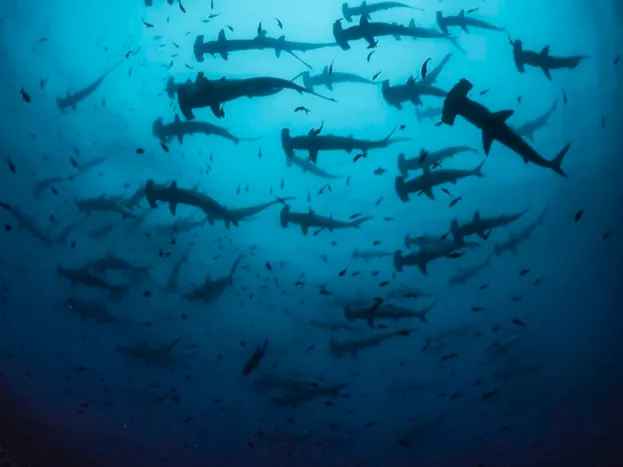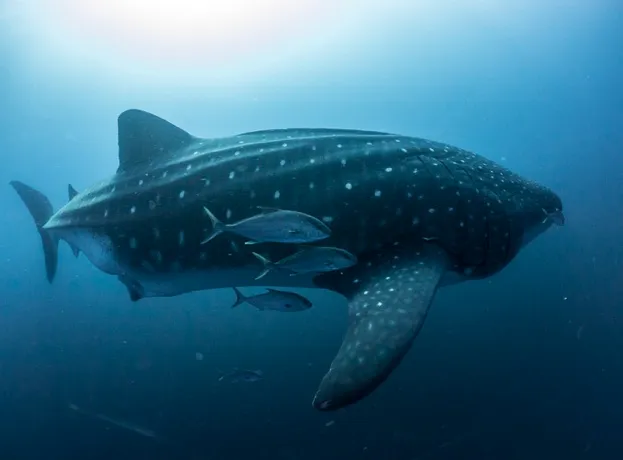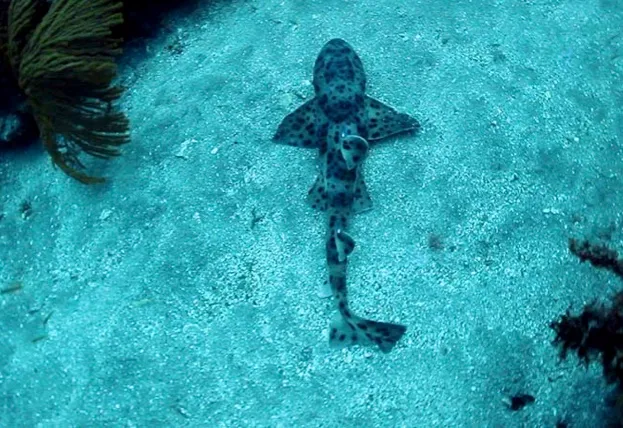1. Diversity
At least 33 species of shark have been recorded in the waters around the Galápagos Islands, including the recently discovered Galápagos ghostshark.
2. Confusingly named
One of the most common shark species seen in the Islands is the Galápagos shark, but confusingly this species is found throughout the Pacific, Atlantic and Indian Oceans. It gained its name because the first specimen described for science was caught in Galápagos in 1905.
3. Hundreds of hammerheads

A school of scalloped hammerhead sharks © Simon Pierce
Galápagos is well-known for its large schools of scalloped hammerhead sharks which are often seen in groups of over 100 individuals. There are few sites in the world where this many are seen together and while there are many theories as to why it occurs, one of the main reasons is thought to be for mating.
Watch a video about the schooling behaviour of hammerhead sharks:
4. Vulnerable to threats
Sharks in the Galápagos Islands face similar threats to those globally, including shark finning and fishery bycatch. They are protected in Galápagos waters by the Galápagos Marine Reserve, but many migrate through the archipelago so face these threats outside of the reserve.
5. Local protection
The Galápagos Marine Reserve, which covers a massive 133,000 km2 had its no-take zones (no fishing) extended in 2016 to cover 40,000 km2 of the Reserve. Some of the extension extends around the northern Galápagos islands of Wolf and Darwin where a high abundance of sharks are found, including the hammerhead schools.
6. Pregnant females

A whale shark in Galápagos © Simon Pierce
Another visitor to Wolf and Darwin is the whale shark. In other parts of the world, aggregations of whale sharks are made up of mostly immature males, but in Galápagos the majority are large mature females. It is thought up to 90% of these could be pregnant females.
7. Lots of learn
There is still much to learn about the life history of the whale shark including where they go to pup. Galápagos Conservation Trust have been supporting the Galápagos Whale Shark Project which tags and tracks whale sharks in and around Galápagos to try and determine where their migration routes take them, and why Galápagos seems to be such an important place for them.
These whale shark tracks will also help to inform conservation management outside of the Galápagos Marine Reserve which is even more important since they were updated from vulnerable to endangered on the IUCN Red List in 2016.
8. Elusive and unknown

Not much is known about the bullhead shark © Max Hirschfield
Whale sharks are not the only shark in Galápagos about which little is known. Research is currently being undertaken looking into the small and elusive bullhead shark in Galápagos. Despite being discovered 175 years ago, it has been assessed as data deficient by the IUCN due to a lack of knowledge.
9. Potential new species
There are plans to undertake genetic analysis of the bullhead sharks in Galápagos as there is a theory that they could be a different species to those found elsewhere in the Pacific Ocean. If this turns out to be true, then the species will be the only endemic Galápagos shark species!

